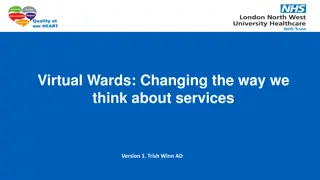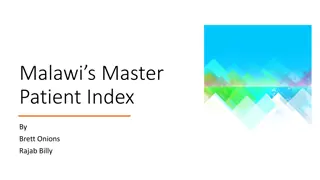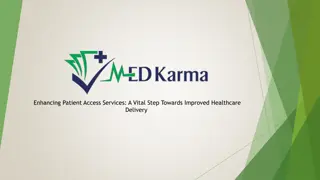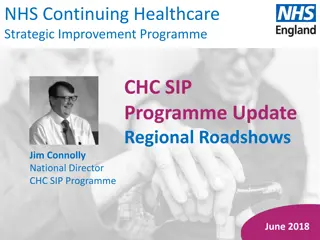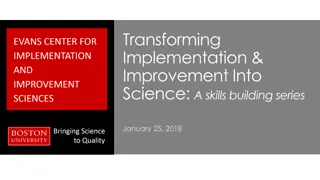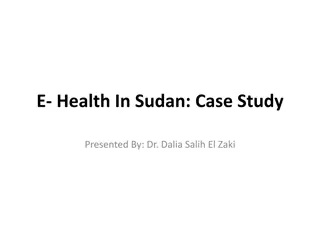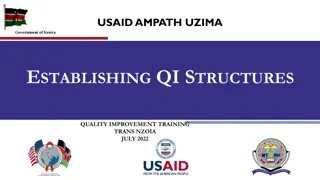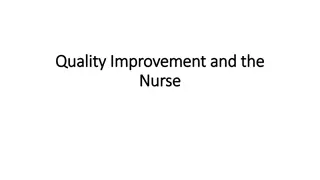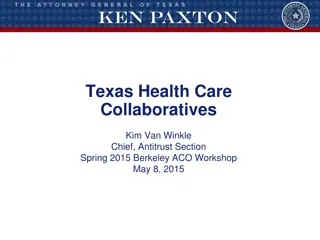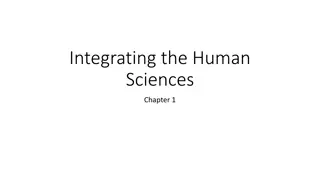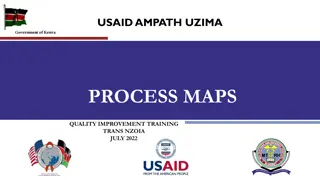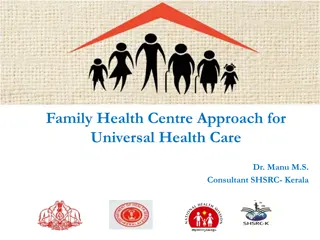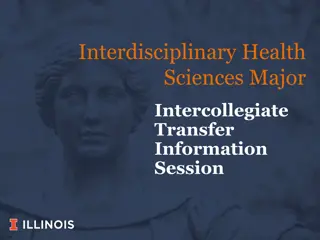Enhancing Healthcare Delivery through Implementation and Improvement Sciences
In this informative series, learn how to effectively implement and assess changes in healthcare delivery using evidence-based practices. Explore the key criteria for identifying high-quality projects and the essential ingredients for successful research proposals in the field. Gain valuable insights into Implementation Science and Improvement Science to optimize healthcare quality and outcomes.
Uploaded on Nov 17, 2024 | 0 Views
Download Presentation

Please find below an Image/Link to download the presentation.
The content on the website is provided AS IS for your information and personal use only. It may not be sold, licensed, or shared on other websites without obtaining consent from the author. Download presentation by click this link. If you encounter any issues during the download, it is possible that the publisher has removed the file from their server.
E N D
Presentation Transcript
Transforming Implementation & Improvement Into Science: A skills building series December 6, 2017
Engage with CIIS Provide guidance, support & innovation to design projects that rigorously evaluate the effectiveness of efforts to implement change Guide & Innovate Accelerate & Promote Sustainability Identify strategies that accelerate the adoption & promote sustainability of effective healthcare interventions Provide implementation & improvement sciences education to faculty, trainees, students Educate
Overview: Implementation & Improvement Sciences Implementation Science Focuses on optimal strategies to promote evidence uptake in real- world settings Addresses Aims Did stakeholders perform the desired endeavor? Why or why not? How well? Translate research intro practice Systematically implement evidence-based practices Improvement Science Focuses on rigorously measuring outcomes associated with efforts to improve care delivery Addresses Did the new endeavor measurably improve desired outcomes? Improve the quality of healthcare
Identifying High-Quality Projects Issues Applying NIH Criteria to Implementation & Improvement (IIS) Main NIH Criteria Overall impact Significance Innovation Approach Investigator team Research environment Broad, non-specific to IIS Criteria could be operationalized to better describe high-quality IIS
Proctors 10 Key Ingredients NIH Criteria Proctor s 10 Key Ingredients for Implementation Research Proposals Quality/care gap Evidence-based treatment Conceptual model, theoretical justification Stakeholder priorities, engagement in change Impact; Significance Significance; Innovation Approach; Innovation Impact; Approach; Research Environment Setting s readiness to adopt new services Implementation strategy/process Team experience with the setting, treatment, processes Impact; Approach; Environment Impact; Significance; Innovation Approach; Investigator Team Feasibility of proposed research design Measurement & analysis section Policy/funding environment; support for sustaining change Approach; Investigator Team Approach; Investigator Team Impact; Significance Source: Writing Implementation Research Grant Proposals: Ten Key Ingredients. Proctor EK, Powell BJ, Baumann AA, Hamilton AM, Santerns RL. Implementation Science. 2012;7:96.
Upcoming Sessions Tentative Date 10/25/2017 Session Title Proposal Areas Addressed Quality/Care Gap, Evidence- Based Practice Conceptual Model Identifying Your Implementation & Improvement Sciences Research Question Using & Discussing Implementation Science Models Implementation Strategies Versus Study Interventions Designing an Implementation & Improvement Sciences Study Quantitative Methods for Implementation & Improvement Sciences Qualitative Methods for Implementation & Improvement Sciences Engaging with Stakeholders to Conduct Feasible & Meaningful Research 12/6/2017 1/25/2018 Implementation Strategy 2/28/2018 Study Design 3/22/2018 Measurement, Analytic Methods Measurement, Analytic Methods Stakeholder Engagement, Feasibility, Team, Policy Environment 4/18/2018 5/10/2018
Series Goal Proctor s 10 Key Ingredients High-Quality Implementation & Improvement Sciences Significant Contributions to Improve Care, Advance Fields CIIS Educational Series
Using & Discussing Implementation Science Models Study Proposal Areas Addressed: Conceptual Model, Theoretical Justification Mari-Lynn Drainoni, PhD, MEd Co-Director, CIIS
Using and Identifying Conceptual Models Gain introductory knowledge of IIS specific conceptual models & how to use models in research Discuss the importance of linking questions, process & outcomes measures to a model Provide some examples of using models to drive study design and activities
What is a Conceptual Model/Framework? An analytic tool capable of identifying a set a variables and relationships that should be examined in order to explain a phenomena (Kitson et al., 2008) Source: Kitson AL, Rycroft-Malone J, Harvey G, McCormack B, Seers K, Titchen A. Evaluating the successful implementation of evidence into practice using the PARiHS framework: Theoretical and practical challenges. Implementation Science. 2008;3:1.
Implementation Models Implementation models individual behavior change models Core characteristics: Focus on provider or systems levels Focus on acceptability, uptake, adoption, sustainability
Are Conceptual Models Helpful? Useful for: Making conceptual distinctions Organizing ideas Can represent ideas in visual formats Pictures Diagrams
How Can Conceptual Models Help My Research? Study design Offer a systematic method for operationalizing, navigating, evaluating complexities of implementation Outcome measures Recipe for replication Inform future research, scalability Generalize knowledge
How Can Conceptual Models Help My Research? Unfortunately, there is no one model that will guide all research questions Important to think about how a model can apply to the specific question you re trying to answer
Practical Application: Formative Assessment of Narcan Distribution in the Emergency Department Model: Promoting Action on Research Implementation in Health Services (PARIHS)
Quality/Care Gap Overdose(OD) is leading cause of accidental death Narcan (naloxone) can reverse overdose but it has to be accessible & timely (before it s needed) Emergency departments (ED) often initial point of contact for care, OD reversal Potential high-yield venue for delivering OD prevention BUT only 8% at-risk patients get narcan kit from ED
Program Objectives What are We Trying to Change? Program Goal: Ensure that ALL patients at risk for OD who appear in ED receive a Narcan kit 35 % At-Risk Patients Receiving 30 25 Narcan Kit 20 ASSERT 15 10 5 0 June July June Oct Feb May Aug Nov Feb Apr May Jan Jan Mar Apr Mar Sept Dec
Program Design Expanded initiative & policy to provide 24-hour coverage to ensure all at-risk patients are offered rescue kits using 3 models Project ASSERT s Licensed Alcohol & Drug Counselors Outpatient pharmacy prescriptions Inpatient pharmacy distribution by ED
Early results What Is/Is Not Working? Early results: Still low numbers, extremely low uptake of non- Project ASSERT component 7% at-risk
Implementation Study New program not being used study to Identify barriers & facilitators to successful distribution of Narcan kits for all at-risk ED patients Use implementation model as a guide Systematic method to identify, understand, operationalize, evaluate implementation Identify set of variables & relationships that can be examined to explain the phenomena Consider context: who is involved, disciplines, intervention, implementation process
Using the PARIHS Model as a Guide Evidence: Research, Experience, Data Context: Facilitation: Skills, style Culture, Leadership, Resources Implementation
PARIHS Model PARIHS 3 constructs: evidence, context, facilitation Success Implementation success predicted by high degrees of each construct Evidence Failure Implementation failure predicted by low degrees of 1 or more constructs Context
Study Methods Formative evaluation: Assess program during development to make early improvements Qualitative methods: 7 focus groups, 6 interviews N=50: 19 MDs, 26 RNs, 3 ASSERT, 2 Pharmacists Qualitative analysis: Grounded theory, constant comparative methods to identify facilitators & barriers Link back to PARIHS model
Facilitators Real-world driven with philosophical, clinician & leadership support for the evidence Why would you be against Narcan? I can t even think of a rational argument .It s like it s something like condoms or That s like being against water Basic education & training efforts conducted Current ASSERT program, 24-hr availability of ED social workers & pharmacists Can leave ED with Narcan kit in hand
Protocol & Policy Barriers No input from those tasked with implementation the people who design the policy actually don t work nightshifts Important potential targets no included Parents of younger patients may be highly receptive, no pediatric ED involvement No clear criteria & lack of consensus of target population I mean, so we re guessing who needs it, who should get it and it s just bad guessing because everybody should be offered So I think you try to focus on the most evident patients who have immediate risk . .in a world of limited resources, you have to decide where you re going to devote your time and effort Need to clearly determine public health role of ED
Workflow & Logistical Barriers Standing verbal order inconsistent with current practice we re only allowed to take verbal orders in life-and death emergencies Paper documentation needed to dispense; no EMR-based option (the verbal order is) a misnomer because a piece of paper for documentation is needed and the pharmacy cannot actually dispense without documentation Staff unfamiliar with process No consensus regarding timing or kit distribution Difficult to track referrals, paper orders, kit dispensing
Patient-Related Barriers Challenging population, impulsive & anxious to leave ED once OD reversed patients did not want their high to have been reversed by Narcan and so are not interested in getting some to go Frequently unaccompanied in ED Unlikely to fill prescription due to inconvenience, stigma, potential co- payment There may be biases about worthiness of patients to receive Narcan kit the staff are human there s the deserving and the underserving ill and (the feeling) this is self- inflicted and not a disease. I don t think people in healthcare are immune to that. We have our own biases. We grew up in a culture where some behaviors are acceptable and not.
Staff Role/Responsibility Barriers Clinical staff feel too busy Not in anyone s specific job description idea that if everyone is responsible, no one is responsible Everyone think it is someone else s role it makes sense to me in that the nurses are the end point of discharge it s part of their role and responsibility, I think, to make sure the patients have a discharge plan . No other medication is the nurses responsibility to give without an order from a physician.
Education & Training Barriers Staff need training in policy & use of kit; training needs to be structured, consistent, ongoing Patients/families need training on Narcan & use of kit Need to determine how to incorporate patient/family training into ED workflow one of the biggest time commitments, educating the patient
Study Results Linked to PARIHS Evidence: Belief in effectiveness, little clinical experience, patients not receptive Facilitation: Context: Style included episodic & didactic training, no creation of partnerships in development or training Leadership support, multiple resources, lack of consensus regarding ED PH role Implementation
Practical Application: Using Community Health Workers for HIV to Improve Linkage & Retention in HIV Care Model: Reach Effectiveness Adoption Implementation Maintenance (RE-AIM)
Project Goals Increase utilization of community health workers (CHWs) to improve access, retention & outcomes among people living with HIV (PLWH) Strengthen HIV healthcare workforce & build capacity of Ryan White HIV/AIDS Program recipients to integrate CHWs into care team Evaluate implementation & effectiveness of different CHW models
Project Structure & Activities 10 Ryan White Care Act funded sites across US to be funded to Implement program with limited funding & limited staffing Receive training Participate in evaluation
Project Structure & Activities 3-year project timeline 12 months: BU team planning including program, curriculum, training development, evaluation design 18 months: Program implementation & evaluation, ongoing training, collect & provide data 6 months: Complete evaluation Evaluation No additional funding for surveys or data provision No funding for control/comparison sites
Study Goals Primary focus: Experience implementing the program from multiple staff/organizational perspectives Secondary focus: Does the intervention work? Assessed via: Client, CHW, site experience with intervention Integration of CHW program into setting Assessed via: Changes in clinical markers, adherence, appointment, attendance, changes in unmet needs
RE-AIM Model Explained RE-AIM 5 concepts/ constructs ask questions to guide research Program maintained over time Who is exposed & benefits Impact on proposed outcome Consistency in application Who applied program & where Adoption
Using RE-AIM as a Guide RE-AIM Concept Key Questions for Concept REACH Who is expected to benefit? What percent of those are actually exposed to intervention? Who are they (demographics)? What is the impact of the intervention on the proposed outcome (clinical markers, retention, adherence)? What settings applied the program? Who applied it? How was the program applied? How consistently was it applied in the way it was intended? Is the program maintained over time? EFFECTIVENESS ADOPTION IMPLEMENTATION MAINTENANCE
RE-AIM Concept Measures Data Sources Reach % eligible who get CHW intervention; Dose of intervention received; Demographics Impact of the intervention on clinical markers, retention, adherence, unmet needs, stigma, self-efficacy, health literacy Frequency of adoption; Where is program adopted Specific activities & dose; Integration of CHWs into team; Adaptions to protocol Medical chart data Client survey Effectiveness Medical chart data Client survey Adoption CHW encounter form Site visit tools CHW encounter form Fidelity monitoring tool CHW satisfaction survey Qualitative interview Site visit tools CHW encounter form Cost analysis Implementation Maintenance Consistency over time; Budget impact
Practical Application: The Hepatitis C Testing & Assessment Project Model: Proctor Conceptual Model of Implementation Research
Research Question & Setting Quality gap High rates of HCV in population born 1945-1964 No evidence for routine testing for all (as with HIV) Research Question: What is the betterstrategy to improve HCV screening & testing within primary care in settings with a large proportion of high- risk patients? Routine birth cohort testing Enhanced risk screening with targeted testing for all others Setting: 3 large community health clinics in South Bronx, New York
Outcome Definition Data Source Implementation Acceptability Adoption Appropriateness Feasibility Fidelity Penetration Agreeable, attitudes Willingness to implement Perception of fit Can they do it Did they do it % eligible that got it Qualitative Qualitative Qualitative Qualitative Screener, EMR testing data Screeners done, EMR testing data Sustainability Does the intervention stick EMR testing data post- intervention Client Symptomatology % tested who tested positive EMR testing data
Outcome Definition Data Source Service Efficiency Did the right people get screened/tested Patient responses Getting people to care Care does not vary by personal characteristics Did the right people get screened/tested Patient responses EMR testing data & risk data, screener risk & testing data Qualitative EMR referrals, linkage EMR demographics linked to screener EMR testing data EMR testing data & risk data, screener risk & testing data Qualitative Patient centeredness Timeliness Equity Efficiency Patient centeredness Getting people to care EMR referrals, linkage Timeliness Did the right people get screened/tested EMR testing data & risk data, screener risk & testing data Efficiency
Results: Screening & Testing Over Time .6 .16 Re-energize .14 Fraction Screened Proportion Tested .4 .12 .1 .2 .08 .06 0 0 5 10 15 Study Week Number Fraction Screened Fraction Tested
# # Tested Positive 17 6 4 % of Total Positives 41.5% 14.6% 9.8% Cumulative % 41.5% 56.1% 65.9% Factor Study Example Using Proctor Ever injected drugs Ever snorted drugs Elevated ALT (documented in EMR) Transfusion before 1992 20+ lifetime sex partners Maternal hepatitis C Liver diseases Ever homeless Every incarcerated Chronic hemodialysis Transplant before 1992 Total Identified 56 200 185 59 115 10 23 66 67 0 0 3 2 1 1 0 0 0 0 8.0% 4.9% 2.4% 2.4% 0.0% 0.0% 0.0% 0.0% 73.1% 78.0% 80.5% 82.9% 82.9% 82.9% 82.9% 82.9% 82.9% 34
Implementation Feedback Good reminder to focus on Hepatitis C Screener increased knowledge about patients Screen time-consuming General preference for screener Birth cohort phase difficult to buy into Remaining ambivalence Process too difficult and not realistic
Practical Issues Considerations when selecting a model: 1) What are the study goals, study type? 2) How flexible does the model need to be? 3) Am I more interested in dissemination or implementation activities? 4) At what level am I intervening? 5) What are the implementation strategies what am I going to do? 6) What do I want to learn from the project?
Level of Construct Flexibility Broad Operational Loosely outlined & assigned constructs Flexible application across broad array of contexts More responsibility on researcher to think through how to operationalize constructs & apply model Concretely & clearly defined constructs Rigid application to a specific context Provides researcher with a detailed, step-by-step process for use Source: Tabak RG, Khoong EC, Chambers DA, Brownson RC. Bridging Research and Practice. American Journal of Preventive Medicine. 2012;43(3):337-350. doi:10.1016/j.amepre.2012.05.024.



